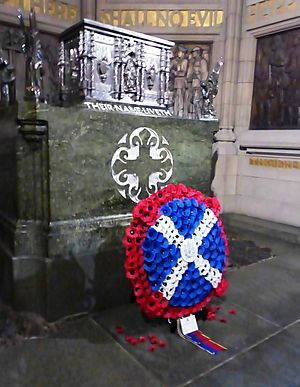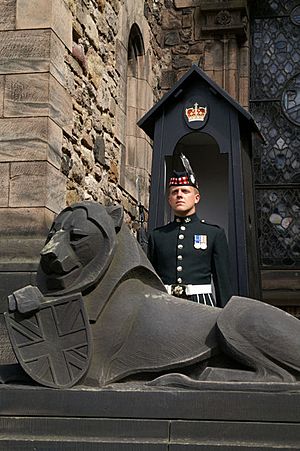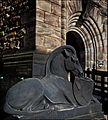Scottish National War Memorial facts for kids
The Scottish National War Memorial is a special place inside Edinburgh Castle. It remembers all the Scottish soldiers, sailors, air force members, and regular people who died in wars. This includes those who served in Scottish regiments. The memorial was built to honor people who died in the two World Wars and other conflicts that followed.
A famous architect named Robert Lorimer designed the memorial. Work started in 1919, and it officially opened in 1927. It is built inside an old army building in Crown Square, right in the middle of the castle. Many smaller memorials are also part of it.
The memorial holds special books called the Rolls of Honour. These books list the names of Scots who died in all wars since 1914. This includes anyone from Scotland who was killed by enemy action. It also lists those who died from injuries or sickness while serving. This covers people in the British Armed Forces, the Merchant Navy, and forces from other countries like the Dominions. Women's services and nursing services are also included. All members of Scottish regiments are listed too.
The Rolls of Honour list people who died between August 4, 1914, and August 31, 1921, for the First World War. For the Second World War, names are listed for those who died between September 3, 1939, and December 31, 1947. If someone was not in a Scottish regiment, they had to be born in Scotland. Or, at least one of their parents had to be born there.
The memorial lists about 135,000 people who died in the First World War. Over 50,000 names are from the Second World War. More names from later wars have also been added. These include conflicts like the Malayan Emergency, the Korean War (1950–1953), and the Falklands War (1982). Names from Operation Banner (1969–2007) during The Troubles and the Gulf War (1990–1991) are also there.
Inside the Memorial Building
The outside of the memorial has cool gargoyles and sculptures. These were made by artists like Pilkington Jackson, John Marshall, and Phyllis Bone. Inside, you will see detailed wall monuments. These monuments remember different army regiments. The beautiful stained-glass windows were created by Douglas Strachan.
The main goal of the memorial was to remember Scots and those in Scottish regiments. It first focused on those who died in the First World War. This covered the time from the start of the war on August 4, 1914, to the end of the war on June 28, 1919.
The Shrine and Rolls of Honour
At the highest point of the Castle Rock, inside a special area called the Shrine, there is an altar. On this altar sits a sealed casket. This casket holds the original Rolls of Honour. It lists over 147,000 names of soldiers who died in the First World War. There are also open lists of names in the main Hall.
After the Second World War, more names were added. Another 50,000 names were put into the Rolls of Honour in the Hall. New names continue to be added there even today. A charity called the Scottish National War Memorial takes care of the memorial.
Gallery
-
The apse
-
A unicorn with a St Andrew's cross flag and a thistle
-
Memorial to the Royal Air Force
-
Unicorn from the royal arms, with a shield showing a St Andrew's cross
-
Gargoyle and the lion with the flag of England from the royal arms
-
Military badge of the Lovat Scouts and a crest from the royal arms
-
Hall with naval ensigns and military colours
Images for kids



















